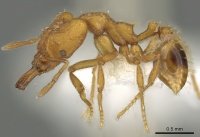Strumigenys odalatra
| Strumigenys odalatra | |
|---|---|

| |
| Scientific classification | |
| Kingdom: | Animalia |
| Phylum: | Arthropoda |
| Class: | Insecta |
| Order: | Hymenoptera |
| Family: | Formicidae |
| Subfamily: | Myrmicinae |
| Tribe: | Attini |
| Genus: | Strumigenys |
| Species: | S. odalatra |
| Binomial name | |
| Strumigenys odalatra Bolton, 2000 | |
The type material was collected from a ground nest in a rainforest.
Identification
Bolton (2000) - A member of the Strumigenys loriae-group. One of the most easily recognised members of the group. It is the only one to combine 2 distinct intercalary teeth, a more or less transverse anterior clypeal margin, and long erect fine hairs on the basitarsi. The standing pilosity of the head, alitrunk and first gastral tergite is shorter here than in any other species of the loriae-group, and is much more obviously flattened and splayed out apically.
Keys including this Species
Distribution
Distribution based on Regional Taxon Lists
Indo-Australian Region: New Guinea (type locality).
Distribution based on AntMaps
Distribution based on AntWeb specimens
Check data from AntWeb
Countries Occupied
| Number of countries occupied by this species based on AntWiki Regional Taxon Lists. In general, fewer countries occupied indicates a narrower range, while more countries indicates a more widespread species. |

|
Estimated Abundance
| Relative abundance based on number of AntMaps records per species (this species within the purple bar). Fewer records (to the left) indicates a less abundant/encountered species while more records (to the right) indicates more abundant/encountered species. |

|
Biology
Castes
Nomenclature
The following information is derived from Barry Bolton's Online Catalogue of the Ants of the World.
- odalatra. Strumigenys odalatra Bolton, 2000: 864, fig. 462 (w.) NEW GUINEA.
Unless otherwise noted the text for the remainder of this section is reported from the publication that includes the original description.
Description
Worker
Holotype. TL 2.9, HL 0.83, HW 0.70, CI 84, ML 0.35, MI 42, SL 0.47, SI 67, PW 0.37, AL 0.80. Apex of mandible with 2 conspicuous intercalary teeth; preapical tooth stoutly conical. Anterior clypeal margin more or less transverse, not deeply indented medially nor broadly V-shaped. In full-face view side of head in front of preocular impression evenly convex, not expanded into a triangular or conical process. Cephalic dorsum reticulate-punctate, without overlying longitudinal rugulae. Dorsolateral margin of occipital lobe with a few short stiff stout projecting hairs that are apically flattened and splayed out. In profile cephalic dorsum at highest point of vertex and near occipital margin with short stiff standing hairs that are apically flattened and expanded; such hairs absent from concavity of transverse dorsal impression where only slightly elevated short ground-pilosity occurs. Promesonotal standing pilosity restricted to humeral pair, a pair anterodorsally on pronotum and a single mesonotal pair; all flattened and expanded apically. Pleurae and side of propodeum reticulate-punctate, sculpture weaker and more superficial on katepisternum. Propodeal spines slender and straight. Bulla of femoral and tibial glands on hind leg visible, small and approximately the same size. Dorsal (outer) surfaces of middle and hind basitarsi with erect long fine simple hairs; similar hairs present on other tarsomeres but absent from tibiae. Petiole node short and bluntly rounded in profile, the lateral spongiform lobe little more than an extension of the collar. Depth of ventral spongiform strip on petiole about half depth of peduncle, extending whole length of petiole. Petiole node in dorsal view much broader than long. Disc of postpetiole smooth, not uniformly reticulate-punctate. Basigastral costulae shorter than length of disc of postpetiole. Standing hairs on first gastral tergite short stiff and blunt, all distinctly flattened and expanded toward the apex. Hairs on tergites 2-4 longer, much more slender, most or all of them finely acute apically.
Paratypes. TL 3.0-3.1, HL 0.83-0.84, HW 0.71-0.72, CI 85-86, ML 0.34-0.36, MI 40-43, SL 0.47-0.48, SI 65-68, PW 0.37-0.38, AL 0.82-0.84 (5 measured).
Type Material
Holotype worker, Papua New Guinea: 3 km. S Wewak, 3°37'S, 143°37'E, 400 m., 15.ii.1989, ground nest, rainforest, #10194 (P. S. Ward) (The Natural History Museum). Paratypes. 12 workers with same data as holotype (BMNH, Museum of Comparative Zoology, University of California, Davis).
References
- Bolton, B. 2000. The ant tribe Dacetini. Memoirs of the American Entomological Institute. 65:1-1028. (page 864, fig. 462 worker described)
References based on Global Ant Biodiversity Informatics
- Bolton, B. 2000. The Ant Tribe Dacetini. Memoirs of the American Entomological Institute 65
- Janda M., G. D. Alpert, M. L. Borowiec, E. P. Economo, P. Klimes, E. Sarnat, and S. O. Shattuck. 2011. Cheklist of ants described and recorded from New Guinea and associated islands. Available on http://www.newguineants.org/. Accessed on 24th Feb. 2011.

